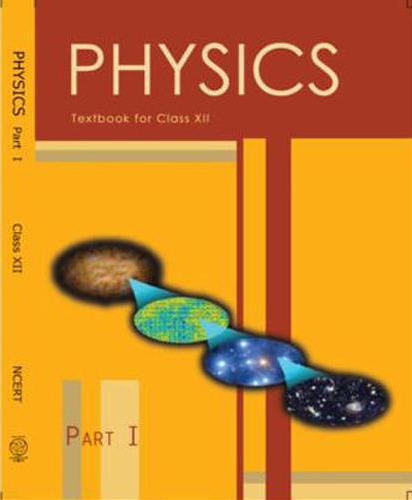Class 11 - Physics
Chapter 1 - Physical world

Top Block 1
Question : 1. Some of the most profound statements on the nature of science have come from Albert Einstein, one of the greatest scientists of all time. What do you think did Einstein mean when he said: “The most incomprehensible thing about the world is that it is comprehensible”?
Answer : The whole of physical world is complex in nature. The biological world has its own complexities. Moreover, vastly different orders of magnitudes are involved in space, time and mass. Inspite of all this, almost all the physical phenomena can be expressed in terms of few basic laws. When viewed in this context, Einstein’s statement becomes very clear.
Question : 2. “Every great physical theory starts as a hearsay and ends as a dogma”. Give some examples from the history of science of the validity of this incisive remark.
Answer : A common observation in our daily life is that light travels in straight line. When Huygens propounded his wave theory, it was against the accepted belief. However, soon it became a dogma as reflection, refraction etc., could be successfully explained on the basis of wave theory. When photoelectric effect was discovered then it was found that wave theory of light cannot explain the phenomena and we came to a conclusion that light truely has dual characteristic. It may behave both as wave and a particle.We may consider other similar examples from the history of science.
Question : 3. “Politics is the art of the possible”. Similarly, “Science is the art of the soluble”. Explain this beautiful aphorism on the nature and practice of science.
Answer : Science is a systematised study of observations. A scientist patiently analyses these observations and comes out with certain laws. As an illustration, Tycho Brahe worked for twenty long years to make observations on planetary motions. It is from this huge reservoir of observations that Kepler formulated his three famous laws of planetary motion. Thus, science is the art of the soluble just as politics is the art of the possible.
Question : 4. Though India now has a large base in science and technology, which is fast expanding, it is still a long way from realising its potential of becoming a world leader in science. Name some important factors, which in your view have hindered the advancement of science in India.
Answer : Some of the important factors which have hindered the growth of science in India are given below:
- Lock of infrastructure and funds for quality research work in science.
- Science education is neither properly oriented nor directed. It needs specific directions depending on our requirements.
- The rural based science education is nearly non-existent so that majority of population is deprived of the benefits of advancements in science and technology.
- Poor pay scales and other facilities to scientists as compared to administrators.
- Indian society is full of superstitions and is highly traditional. Therefore, they are slow in adopting the new scientific trends.
- There is practically no co-ordination between the researchers and the industrialists. The industrialists are the actual consumers of new research and technology. The industrialists of this country have little confidence in the ability of the Indian scientists.
Question : 5. No physicist has ever “seen” an electron. Yet, all physicists believe in the existence of electrons. An intelligent but superstitious man advances this analogy to argue that ‘ghosts’ exist even though no one has ‘seen’ one. How will you refute his argument?
Answer : Many phenomena which depend upon the existence of electrons have been predicted and actually observed in everyday life. There is no phenomenon which can be explained on the basis that ghosts exist though they are not seen. So, obviously, the comparison between two situations does not make any sense.
Question : 6. The shells of crabs found around a particular coastal location in Japan seem mostly to resemble the legendary face of a Samurai. Given below are two explanations of this observed fact. Which of these strikes you as a scientific explanation?
(a) A tragic sea accident several centuries ago drowned a young Samurai. As a tribute to his bravery, nature through its inscrutable ways immortalised his face by imprinting it on the crab shells in that area.
(b) After the sea tragedy, fishermen in that area, in a gesture of honour to their dead hero, let free any crab shell caught by them which accidentally had a shape resembling the face of a Samurai. Consequently, the particular shape of the crab shell survived longer and therefore in course of time the shape was genetically propagated. This is an example of evolution by artificial selection.
[Note: This interesting illustration taken from Carl Sagan’s ‘The Cosmos’ highlights the fact that often strange and inexplicable facts which on the first sight appear ‘supernatural’ actually turn out to have simple scientific explanations. Try to think out other examples of this kind],
Answer : (a) The explanation given in option (b) strikes as a scientific explanation.
Question : 7. The industrial revolution in England and Western Europe more than two centuries ago was triggered by some key scientific and technological advances. What were these advances?
Answer : Some of the key advances during that period in science and technology include the application of heat and thermodynamics to form the steam engine. Discovery of electricity helped in designing dynamos and motors. Study of gravitation led to the study of motion and making guns and cannons. This gave power in the hands of western countries and they ruled over rest of the world. The discovery of explosives not only helped army but also mineral exploration. These are some examples of scientific and technological advances which helped England and Europe to have their prominent positions in the world. In fact, the progress in chemistry, physics and natural sciences brought the industrial revolution in England and western Europe.
Question : 8. It is often said that the world is witnessing now a second industrial revolution, which will transform the society as radically as did the first. List some key contemporary areas of science and technology, which are responsible for this revolution.
Answer : Some key contemporary areas of science and technology, which are chiefly responsible for a new industrial revolution taking place now and likely to take place in near future are: (i) Design of super-fast computers.
- Biotechnology.
- Developments in the field of space sciences.
- Development of super-conducting materials at room temperature.
- Advancements in the field of electronics, information technology and nanotechnology.
Question :9. Write in about 100 words a fiction piece based on your speculation on the science and technology of the twenty-second century.
Answer :
- The development on the front of genetic engineering and biotechnology will include:
(a) Production of man, animals and plants with specific characteristics.
(b) High yielding variety of plants and specific crops would be sown. - Multiple use of laser in various fields or even more developed device which will transform the world. Man would treat himself as the king of universe.
- Man may travel in space with unthinkable speeds and transportation would be totally revolutionised.
- (iv) Man would travel deeper into the space and may settle on other planets, befriend strange creatures from other worlds or may wage a war with them.
- In the field of communication, 22nd century has many surprises in store. Two persons sitting on the globe or on moon would talk on phone face to face.
- Man may partially conquer diseases and slow down ageing.
Question : 10. Attempt to formulate your ‘moral’ views on the practice of science. Imagine yourself stumbling upon a discovery, which has great academic interest but is certain to have nothing but dangerous •consequences for the human society. How, if at all, will you resolve your dilemma?
Answer : A scientist aims at truth. A scientific discovery reveals a truth of nature. So, any discovery, good or bad for mankind, must be made public. A discovery which appears dangerous today may become useful to the mankind some time later. In order to prevent misuse of scientific technology, we must build up a strong public opinion. Scientists should in fact take up two roles – to discover truth and to prevent its misuse.
Mddle block 1
Question : 11. Science, like any knowledge, can be put to good or bad use, depending on the user. Given below are some of the applications of science. Formulate your views on whether the particular application is good, bad or something that cannot be so clearly categorised:
(a) Mass vaccination against small pox to curb and finally eradicate this disease from the population. (This has already been successfully done in India.)
(b) Television for eradication of illiteracy and for mass communication of news and ideas.
(c) Prenatal sex determination.
(d) Computers for increase in work efficiency.
(e) Putting artificial satellites into orbits around the Earth.
(f) Development of nuclear weapons.
(g) Development of new and powerful techniques of chemical and biological warfare.
(h) Purification of water for drinking.
(i) Plastic surgery.
(j) Cloning.
Answer : (a) Good, because it helped in eradicating a dreaded disease from the Earth.
(b) Good, because it helps in literacy campaign and is an effective method of mass communication and entertainment.
(c) Bad, because it leads to practice of abortion in case of female foetus.
(d) Good, because it increases work efficiency.
(e) Good, because it helped in worldwide communication process.
(f) Bad, because nuclear weapons may cause mass destruction of mankind.
(g) Bad, because these techniques may be used for destructive purposes.
(h) Good, because pure water supply will improve the health of people.
(i) Plastic surgery is something which cannot be classified as either good or bad. The technique helps to remove certain type of deformations in needy persons. But plastic surgery for cosmetic purposes is not good.
(j) Cloning is bad because it has the potential to destroy the normal family life of human society.
Question : 12. India has had a long and unbroken tradition of great scholarship in mathematics, astronomy, linguistics, logic and ethics. Yet, in parallel with this, several superstitious and obscurantistic attitudes and practices flourished in our society and unfortunately continue even today among many educated people too. How will you use your knowledge of science to develop strategies to counter these attitudes?
Answer : In order to popularise scientific explanations of everyday phenomena, mass media like radio, television and newspapers should be used. We shall use our knowledge of science to educate masses and shall try to tell them the real cause of an event so that their superstitious beliefs are rejected.
Question : 13. Though the law gives women equal status in India, many people hold unscientific views on a woman’s innate nature, capacity and intelligence; and in practice give them a secondary status and role. Demolish this view using scientific arguments, and by quoting examples of great women in science and other spheres; and persuade yourself and others that, given equal opportunity, women are on par with men.
Answer :There is no difference in the capacity of women and men as far as work, intelligence, decision making is concerned. The nature makes little difference in man and woman in their anatomy and feeling.
The nutrition content of prenatal and postnatal diet contributes a lot towards the development of human mind. If equal opportunities are afforded to both men and women, then the female mind will be as efficient as male mind.
The list of successful women from various fields is very large. Names of Kalpana Chawla, Sarojini Naidu, Madame Curie, Indira Gandhi, Margaret Thatcher, Mother Teresa, Florence Nightingale drawn from fields varying from science to sociology are very well-known to the world.
Question : 14. “It is more important to have beauty in the equations of physics than to have them agree with experiments.” The great British physicist P.A.M. Dirac held this view. Criticize this statement. Look out for some equations and results in this book which strike you as beautiful.
Answer : Generally it is considered that physics is a dry subject and its main aim is to give qualitative and quantitative treatment i.e., any derived relation or equation must be verified through experimentation. It is felt that truth of an equation is more important than the simplicity, wonderfulness, symmetry or beauty of the equation. But frankly, if a relation is true to experimentation and simultaneously it is simple, interesting, symmetrical, wonderful or beautiful, it will certainly add to the charm of the relation.
Question : 15. Though the statement quoted above may by disputed, most physicists do have a feeling that the great laws of physics are at once simple and beautiful. Some of the notable physicists, besides Dirac, who have articulated this feeling are: Einstein, Bohr, Heisenberg, Chandrasekhar and Feynman. You are urged to make special efforts to get access to the general books and writings by these and other great masters of physics. Their writings are truly inspiring.
Answer : General books on Physics make an interesting reading. Students should consult a good Library to go through some of these immortal works. ‘Surely you are joking, Mr. Feynman’ by Feynman is one of the books that would assume the students. Some other interesting books are: Physics for the Inquiring Mind by EM Rogers; Physics, Foundations and Frontiers by G. Gamow; Thirty Years That Shook Physics by G. Gamow; Physics Can Be Fun by Perelman.
Question : 16. Textbooks on science may give you a wrong impression that studying science is dry and all too serious and that scientists are absent-minded introverts who never laugh or grin. This image of science and scientista is patently false. Scientists, like any other group of humans, have their share of humorists, and many have led their lives with a great sense of fun and adventure, even as they seriously pursued their scientific work. Two great physicists of this genre are Gamow and Feynman. You will enjoy reading their books listed in the Bibliography.
Answer: The statement ”scientists, like any other group of humans, have their share of humorists” is true. We can cite the example of many scientists who were fun loving, adventurists, jovial. One can add the name of C.V. Raman who enjoyed music in addition to doing serious scientific works and so was Homi Jahagir Bhaba. Students should go through the listed books of bibliography to visualise actual image of science and scientists.
Bottom Block 3
Click here to visit Official CBSE website
Click here for NCERT solutions
Click here to visit Official Website of NCERT
Click here to download NCERT Textbooks


